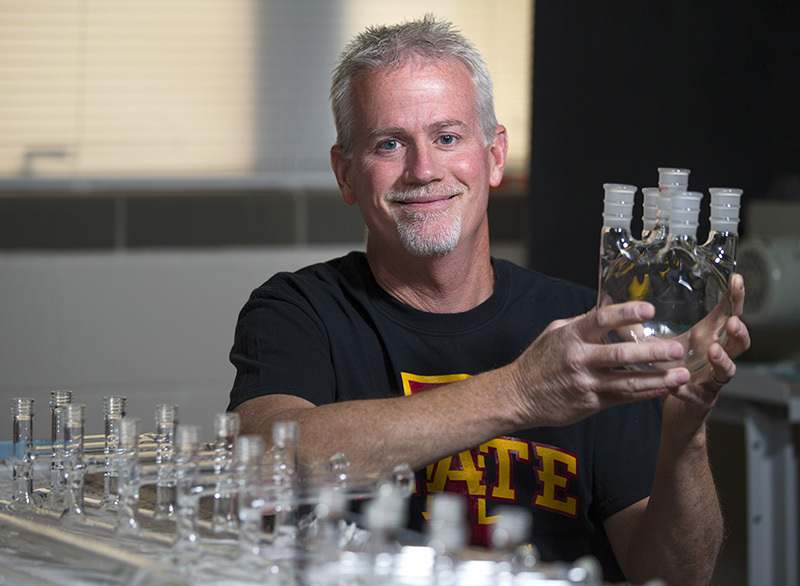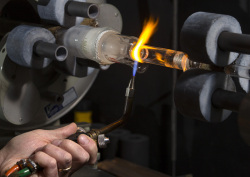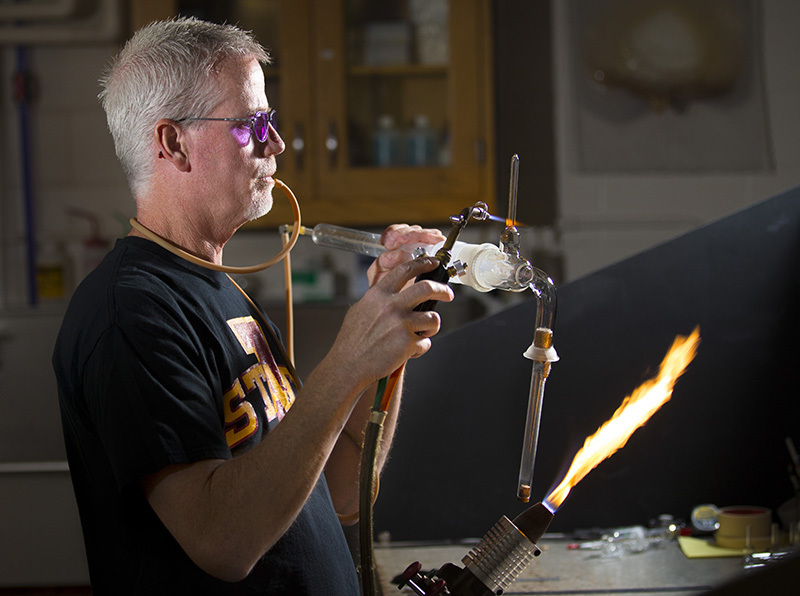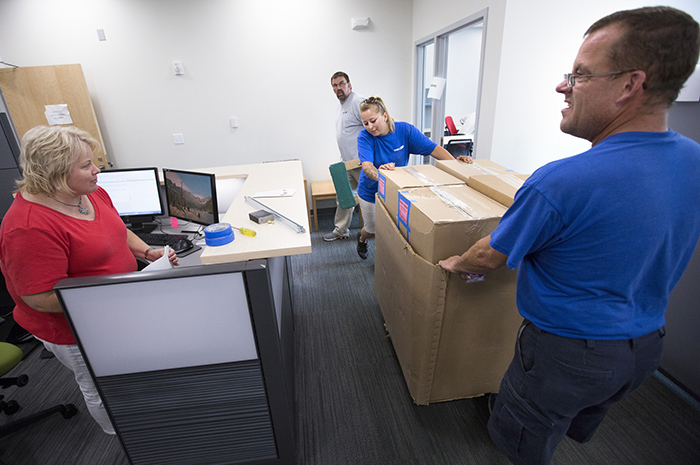Five questions for a master of glass

Tucked away in the northeast corner of the Gilman Hall basement is a one-man shop. Trond Forre is a scientific glassblower -- one of only two in the state of Iowa -- and manager of the chemistry department’s glass shop. The Ames native has been at Iowa State since 1988, learning and mastering a craft that’s serving clients on campus and around the world.
The basics
Name: Trond Forre (pronounced TRON FOUR-ee)
Position: Scientific glassblower
Time at ISU: 28 years
Previous post: Glassblower, Hach Chemical (Ames)
How did you get started?
I worked at Hach Chemical -- they had a production glass shop. We made vials, little flasks and pieces for some of the equipment that they sold. They were more on the scientific side. When this scientific glassblower position opened up, I took this job and started my [five-year] apprenticeship.
How is scientific glassblowing different from what the Gaffer's Guild does?
They're artistic. They have a big furnace that runs 24/7. It's soft glass -- like window glass -- and doesn't take as much to heat it up. Once the piece is done, they have to hurry up and rush it into the oven.
I use borosilicate glass, which is pyrex -- like your cookware at home. It's really, really durable. The other type of glass I use is quartz. Mainly, I use tubing and rods, and sometimes plate glass [of all types]. I can set [my glass] in the annealing oven and it won't crack. It's that much stronger. I use torches and a bench torch, with natural gas and oxygen -- the flames are super hot.
What kind of items do you work on?

Photos by Christopher Gannon.
It's all customized, specialty and repair work. If somebody wants a beaker with four tubes sticking out of the side of it so they can add stuff, I'll do that. If a researcher comes in with a drawing, I know what they want and that's what I build. I may not know exactly what [experimentation] they want to do with it, but the function of the glassware I do know a lot about. I take into consideration things like temperatures, pressures, chemicals, light sources and durability. There are different properties of different glasses that they don't know, but I know. Then we figure that out as they're wanting a piece made.
Who are your clients?
I keep pretty busy. I do a lot of work for other universities and outside companies. I do work for all of Iowa State, the research park and anyone who has an account -- pretty much anybody and everybody that needs the service. Usually, summertime is the busiest. I mainly do work for the grad students, scientists and professors. In the summer, they may not have to teach classes and they really concentrate on their research. I've also made wedding cake tops, swans, pigs and turtles. And, I get quite a few tour groups. The kids like it.
How often do you clean up broken glass?
I've learned. It doesn't happen very often. Every once and a while, I'll be working on something and it will crack. "Tink." That's the worst thing a glassblower can hear ... "tink." So then, I've got to start over. It's a little on the dangerous side, as far as fires and getting cut. I've had stitches and burned myself. It's part of the job.

Accessibility stylin'
Inaccessibility can sneak into websites, email and other digital content in unexpected ways. Uploaded Word documents, for example. Many Word docs posted to the internet don't meet accessibility standards. Often, the problem is improperly structured documents that prevent voice-to-text screen readers from making sense of the documents. Poor structure also can hinder easy access for those with learning disabilities as well as general audiences.
Fortunately, the fix is fairly easy. These tips will help you create accessible Word docs that look (and sound) good.
Accessibility assist
Got questions? Contact web accessibility coordinator Zayira Jordan, zjordan@iastate.edu.
It's all about structure
Those who see a document grasp its structure at a glance. The large, boldface type at the top surely is the headline. Smaller boldfaced lines mark the subheads. Bullets, squares or other tiny icons distinguish items in a list. And words decorated with italics or color signify special meaning.
Unfortunately, fonts, bullets and other visual cues are useless to screen readers. These devices need structural markup that essentially conveys information like this:
- This is the main header and these are lesser heads
- Here's a list
- This word should be emphasized
How do you get structural markup into your documents? Simply use Word's styles and tools to format your copy. Word will take it from there, automatically inserting the hidden markup that makes documents accessible.

Word's heading styles are in the ribbon (top, right)
Styling headers
All headers (large and small) should be formatted using the heading styles located in the ribbon on Word's home tab. Look for the "styles" section. To apply a style to the main header, highlight the header and click "Heading 1" in the style box. Give the next most important heads "Heading 2" styles, third-level heads "Heading 3" styles and so on.
How screen readers react
Styled headers allow individuals using screen readers to scan documents by skipping from header to header. When a screen reader encounters a header, it announces the heading level, then the headline. For example, the screen reader might announce "heading level 1, how to create accessible Word docs" or "heading level 2, it's all about structure."
Customizing the look
When you apply headers or other styles in a document, Word displays the copy in its default style. For example Word's default style for "heading 1" is 16-point Calibri blue. If you don't like that look, you can change the default by right-clicking the heading style button and making your own selections. These cosmetic changes won't interfere with screen readers.
Styling the rest
Use Word's style and tools on the rest of the document. For example, bullet and number options in the "home" tab create lists. Screen readers will respond by announcing each list and the number of items it contains.
For special sections or words, apply one of Word's ready-made styles, such as "strong" or "emphasis."
Use the "normal" style for routine text.
Adding descriptions to images
Images, charts and other art require "alt text," a description of the object. Alt text for the ISU logo might be: "Iowa State." Alt text for an ISU enrollment chart might be: "ISU enrollment has set new records for seven consecutive years, from 27,945 students in 2009 to 36,001 students in 2015."
To add alt text to an image or chart:
- Right-click the object
- Click "format picture"
- Click the "layout and properties" icon
- Click "alt text" button
- Fill in the description box and close
Special formatting for tables
To be accessible, tables need both header rows and alt text. To include a header row in a table:
- Click anywhere in the table
- On the table design tab at the top of the page, check the header row box
- Add header info across the top row
-
Right-click the table, then go to "table properties" and click the "row" tab. Ensure that:
- "Allow row to break across pages" is unchecked
- "Repeat as header row at the top of each page" is checked
To add alt text to a table:
- Right-click the table
- Click "table properties"
- Click the "alt text" button
- Enter text in the "description" section
Hyperlinks should be clear, not mysterious
Hyperlinks that take you where you never expected to go are even more annoying when using a screen reader. Hyperlinks should be unambiguous and descriptive. A hyperlink that connects to Iowa State's homepage should say "Iowa State University" or "Iowa State University homepage." It shouldn't say "click here" or "Cyclone country" or "Iowa's land-grant."
Fonts
Font styles and sizes aren't much of an issue for those using screen readers. However, undersized or hard-to-read fonts certainly create accessibility issues for many individuals who don't have 20-20 vision. The standard recommendation is to use familiar sans serif types (such as Arial, Verdana, Tahoma, Helvetica or Calibri) in 12 points or larger.
Add document properties
Word docs must contain certain basic information to meet accessibility standards. To insert info into your document, go to "properties" under Word's "file" menu. To meet standards, fill in the title, subject, keywords and author. You'll also need to fill in the language for your document. On PCs, look for the "custom" tab in the "properties" section. On Word for Macs, "language" lives under the "tools" menu.
Word accessibility checker
An accessibility checker is available for some new and old versions of Word for PC. A checker is not available in newer versions of Word for Mac.
Here's how to check the accessibility of your Word (PC version) docs.
- With Word 2016, chose the "file" menu. Click "check for issues," then "check accessibility." Results and fixes will display in the right panel.
- On Word 2013, pull down the "file" menu to "inspect document" and then "check accessibility"
Related stories
- Accessible PowerPoints are on students' wishlist, March 30, 2017
- Captioning, with an assist from YouTube, Jan. 5, 2017
- Well formed forms, Oct. 20, 2016
- Links that do the job, Sept. 1, 2016
- Color your website accessible, July 21, 2016
- How to create accessible Word docs, June 23, 2016
- The art of alt text, June 9, 2016
IR director search to begin soon

Institutional research staff member Janet Johnson (left) looks on Monday as a moving crew arrives with yet another pallet of boxes at the Kingland Building in campustown. IR is one of the final offices to arrive, completing Iowa State's occupancy of the building's second floor. Photo by Christopher Gannon.
Summer has brought a season of change to ISU's office of institutional research, including a new location and a leadership change. Earlier this week, the institutional staff completed a move from Beardshear's third floor to the Kingland Building in campustown.
The staff joins a handful of other university tenants on the second floor of Kingland, including the Iowa State Daily Media Group, ISU Foundation call center and university relations. Two service units within the vice president for research umbrella, offices for responsible research and research integrity, also moved this week and complete the ISU tenant list at Kingland. All employee phone numbers remain the same.
New Kingland tenants
- Office of Institutional Research, Suite 203
- Office for Responsible Research, Suite 202
- Office of Research Integrity, Suite 202
2420 Lincoln Way 50014-8340
Director search
Associate director of institutional research Sandy Gahn will become interim director on July 1. Gebre Tesfagiorgis, who has led the office since 2001, will retire from the university on June 30.
A national search will begin soon with the goal of having the next director on board by early fall. Associate vice president for academic planning and resources Ellen Rasmussen said she will include representatives from across campus on a committee that will conduct the search. Rasmussen said a regular seven-year program review of the office recently was completed and that some recommendations in that final report will help guide the director search.
When it's fully staffed, institutional research is a seven-person unit. One of its four research analyst positions currently is vacant.
In support of university planning and decision making, the IR team collects, analyzes, interprets and shares timely information on all aspects of Iowa State. Some of its more heavily used products include the annual Fact Book, student profile and faculty salary comparison.
Celebrate lilies, bees at Reiman Gardens

Photo courtesy of Reiman Gardens.
Visitors get two for one on Saturday, June 25, with the Iowa Regional Lily Society's annual show (9 a.m.-4 p.m.) and the Pollinator Fest (10 a.m.-2 p.m.) at Reiman Gardens. The lily show features hundreds of North American lily varieties in the events hall. Educational displays and interactive activities involving several ISU groups are part of the lineup for the National Pollinator Week celebration.
Admission is $8 for adults, $7 for seniors, $4 for youth and free for kids three and younger. A $2 coupon, valid from 10 a.m. to 2 p.m. on Saturday, is available online.
Visitors keep campus busy during summer
Many events -- from local to global -- will bring thousands of visitors to campus this summer. The following is a look at the groups (expecting 100 or more participants) that Iowa State will welcome over the next couple months.
